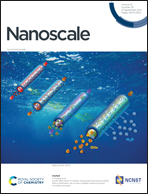In vivo dual fluorescence imaging of mucin 1 and its glycoform in tumor cells†
Abstract
The most efficient approach for cancer identification and monitoring is the detection of cancer-associated protein biomarkers but an accurate diagnosis requires multiple analyses. Glycosylation profiling can provide important biological information since different glycoforms are involved in malignant transformation. Here, a near-infrared (NIR) light activated fluorescence resonance energy transfer (FRET) strategy for the efficient and reliable simultaneous dual imaging of the mucin 1 (MUC1) protein backbone and MUC1-specific sialic acid (Sia) is reported. MUC1, an important tumor biomarker, is overexpressed and under-glycosylated in most tumor cells. Two aptamer-functionalized nanoprobes, Cy5-labeled Sia aptamer-functionalized gold nanostars (Sia-GNSs) and MUC1 aptamer-functionalized quantum dots (MUC1-QDs), were successfully constructed with high specificity and biocompatibility. Upon excitation with NIR light, Sia-GNSs endothermically released the Cy5-labeled Sia aptamer that specifically binds to Sia. The Cy5 fluorescence can be observed due to the FRET effect when the Cy5-labeled Sia aptamer and MUC1-QDs bind to the same MUC1 molecule. Dual imaging and relative quantification of MUC1 and its sialylation were achieved in vitro, in vivo and in clinical tissue samples. This efficient platform allows for the simultaneous detection of protein biomarkers and their glycosylation pattern, with significant potential for clinical cancer diagnostics.



 Please wait while we load your content...
Please wait while we load your content...